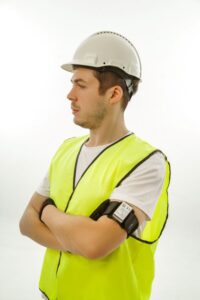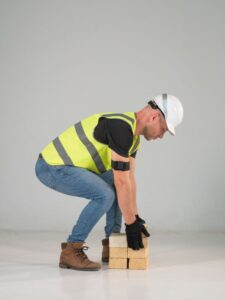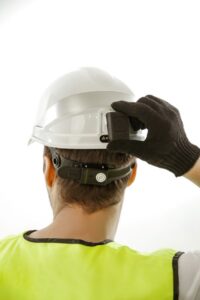Strategies for preventing machinery breakdowns led Matthew Hart to revolutionise injury prevention in the workplace.

Matthew Hart
Wearable technologies are becoming more powerful and effective thanks to increasing computing power and well documented advances in AI.
Nevertheless, a pioneer in using the technology to prevent workplace injuries stresses that applications can still easily go awry without customer input and a frank appraisal of what constitutes viable and worthwhile use cases.
Matthew Hart, who co-founded Soter Analytics with fellow technologist Alexei Pavlenko in 2016, spoke to SHP ahead of an interactive showcase of its workplace safety technologies at Safety & Health Expo 2023.
Risk data collection
Soter Analytics helps workers avoid muscular-skeletal injuries through a combination of smart wearables, AI-driven vision recognition technologies and a risk data collection and visualization dashboard.
The company, which has offices in the US, UK and Australia, is used by more than 120 organizations including GAP, Coca Cola and Travis Perkins.
Soter Analytics says that that more than 38,000 workplace injuries occur around the world each hour, and the most common causes of injuries leading to days away from work are overexertion and slips, trips and falls.
However, prevailing “injury prevention methods such as in-class manual material handling training or ergonomic coaching are resource-consuming, almost impossible to scale and guarantee no tangible result”, claims the company.
By contrast, Soter says its platform can achieve up to 86% reductions in back and shoulder ergonomic injuries, up to 67% falls in worker compensation costs and lower employee turnover – resulting in a potential 250% or greater return on investment.
Origin story
 “What sets us apart is how we prevent those injuries,” says Matthew Hart.
“What sets us apart is how we prevent those injuries,” says Matthew Hart.
The mechanisms for doing so were inspired by Hart’s experience as a site reliability engineer at some of the world’s biggest mine sites.
Machinery breakdowns were avoided “via live sensor data, building models to analyse that data in real time, and predicting breakdowns before they happened,” he explains. “Then you could build those predictions into a preventive maintenance strategy and stop those $10 million-an-hour losses from lost production when you lose a machine.”
Hart surmised that humans could be protected in a similar way.
“When it came to humans, they were just waiting for the injuries to happen,” he recalls. “And I thought well, I’ve seen something that works. Let’s put a sensor on people. Let’s get live data. Let’s stop the injuries before they happen.
“And one of the most effective ways I found to do this at scale was to give people information in real time to make the right decisions and avoid their own injury.”
Haptic biofeedback
 Whether the worker is twisting, bending or lifting, Soter Analytics’ wearable devices can track all relevant bodily movements.
Whether the worker is twisting, bending or lifting, Soter Analytics’ wearable devices can track all relevant bodily movements.
Algorithms analyse these movements in real time and, if the bodily force exerted passes hazardous thresholds, workers receive real time notifications in the form of a vibration.
This ‘haptic biofeedback’, allied with follow-on reporting and training, means “we help them reduce those movements over time and significantly reduce the chances of getting an injury”, says Hart.
Wincanton, a British logistics giant, apparently achieved a 30% reduction in ‘spine hazards per hour’ in its warehouses – such as incidences of unsafe bending, back twisting and repetitive movements – according to a case study of a Soter programme.
Hart says involving customers in the development process from the outset was a fundamentally important decision. “We develop something, test if it works, get the customer feedback and then make changes based on what customers or users are telling us,” he explains
The alternative – having engineers diagnose and solve problems in isolation – means you “just build something that actually doesn’t work in the real world”.
The upshot of this collaborative approach is that “we’ve seen our hardware get cheaper, smaller, easier to use and more reliable”, adds Hart.
AI implications
 Accelerating processing speeds have naturally enabled ever-more sophisticated real time analytics.
Accelerating processing speeds have naturally enabled ever-more sophisticated real time analytics.
But the real gamechanger right now is AI, says Hart.
“We’ve always had our own AI models analysing the data but now there’s a lot of third-party AI you can plug in,” he explains. “So you can take huge datasets and make really interesting observations and analytics and advise organisations not only on improving safety, but more and more to help with their productivity as well.”
Hart expects AI plugins will help Soter Analytics further tailor the Soter platform to individual workers over the next 12 months with personalised advice and tutorials on understanding and mitigating the risks they face in the workplace.
Addressing the longer term implications of AI, he says: “I can’t imagine in 20 to 30 years any worker in the world not using some sort of AI-driven technology to help them work smarter, to assist with their creativity and – most importantly – keeping them safe.
“That’s such a big change we’re about to see in the market and it’s pretty exciting to be at the forefront.”
You can enjoy live, interactive demos of Soter Analytics’ technology at Safety & Health Expo 2023, taking place at ExCeL London, on 18 May.
“I really want people to understand how technology like ours can enable behavioural changes and how we put the worker or employee at the centre of the whole thing,” says Hart. “Empowering them to avoid injury is the perfect scenario for us.”
As for business benefits, Hart will also demonstrate how the Soter Analytics platform results in “employees actually working faster but safer, employee turnover being lower and employees being happier”.
Approaches to managing the risks associated Musculoskeletal disorders
In this episode of the Safety & Health Podcast, we hear from Matt Birtles, Principal Ergonomics Consultant at HSE’s Science and Research Centre, about the different approaches to managing the risks associated with Musculoskeletal disorders.
Matt, an ergonomics and human factors expert, shares his thoughts on why MSDs are important, the various prevalent rates across the UK, what you can do within your own organisation and the Risk Management process surrounding MSD’s.


 “What sets us apart is how we prevent those injuries,” says Matthew Hart.
“What sets us apart is how we prevent those injuries,” says Matthew Hart. Whether the worker is twisting, bending or lifting, Soter Analytics’ wearable devices can track all relevant bodily movements.
Whether the worker is twisting, bending or lifting, Soter Analytics’ wearable devices can track all relevant bodily movements. Accelerating processing speeds have naturally enabled ever-more sophisticated real time analytics.
Accelerating processing speeds have naturally enabled ever-more sophisticated real time analytics.